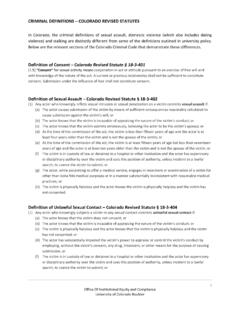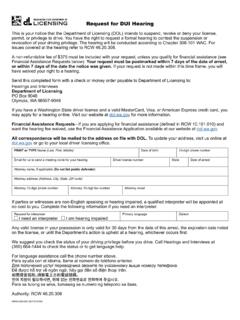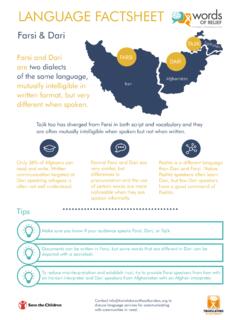Transcription of Language, Dialect, and Register: Sociolinguistics and the ...
1 Language, Dialect, and Register: Sociolinguistics and the Estimation ofMeasurement Error in the Testing ofEnglish Language LearnersGUILLERMO SOLANO-FLORESU niversity of Colorado at BoulderThis article examines the intersection of psychometrics and sociolinguists in the testingof English language learners (ELLs); it discusses language, dialect, and register assources of measurement error. Research findings show that the dialect of the languagein which students are tested ( , local or standard English) is as important aslanguage as a facet that influences score dependability in ELL testing. The devel-opment, localization, review, and sampling of items are examined as aspects of theprocess of test construction critical to properly attaining linguistic alignment: thecorrespondence between the features of the dialect and the register used in a test, andthe features of the language to which ELLs are exposed in both formal and instruc-tional well recognized, the impact of language on the validity of tests isyet to be properly addressed.
2 Since testing typically depends on the use oflanguage, to a large extent an achievement test is a test of language pro-ficiency (American Educational Research Association/American Psycholog-ical Association/National Council on Measurement in Education, 1999).Language remains the prime construct-irrelevant factor in testing a factorthat an instrument does not intend to measure yet affects test scores (seeMessick, 1989).Although language is always an issue in testing, it becomes a much moreserious problem when students are not proficient in the language in whichthey are tested. Efforts in the field of testing accommodations for Englishlanguage learners (ELLs) have rendered results that speak to the difficultyof addressing this challenge.
3 The effectiveness of the linguistic simplificationof items is limited by factors such as the ELL students language back-grounds ( , Abedi & Lord, 2001; Abedi, Lord, Hofstetter, & Baker, 2000).Moreover, language interacts with mathematics achievement in tests inTeachers College RecordVolume 108, Number 11, November 2006, pp. 2354 2379 Copyrightrby Teachers College, Columbia University0161-4681ways that are different for ELL students and their non-ELL counterparts(Abedi, 2002).The issue of language as a construct-irrelevant factor in ELL testing isaggravated by inappropriate or inconsistent testing practices and on the linguistic proficiency of ELLs is usually fragmented orinaccurate (De Avila, 1990), and the criteria and instruments used to classifystudents as ELLs are not the same across states (Abedi, 2004; Aguirre-Mun oz & Baker, 1997).
4 Even attempts to characterize the linguistic pro-ficiency of ELLs based on the kind of bilingual programs in which they areenrolled (or whether they are in any bilingual program at all) may be flawedbecause these programs vary considerably in type and fidelity of imple-mentation (Brisk, 1998; Gandara, 1997; Krashen, 1996), and their success isshaped by a multitude of contextual factors (Cummins, 1999).Several authors ( , LaCelle-Peterson & Rivera, 1994; O. Lee, 1999,2002, 2005; Lee & Fradd, 1998; Solano-Flores & Nelson-Barber, 2001;Solano-Flores & Trumbull, 2003) have asserted that existing approaches todealing with diversity are limited because they lack adequate support fromcurrent theories of language and culture.
5 This gap between disciplines iswell illustrated by results from a recent review of surveys of ELL testingpractices (Ferrara, Macmillan, & Nathan, 2004). This study revealed thatamong the accommodations reported for ELLs are actions of dubious rele-vance to language such as providing enhanced lighting conditions bor-rowed from the set of accommodations created for students with disabilities(see Abedi, Hofstetter, & Lord, 2004). Although these irrelevant accom-modations are well intended and may contribute to enhancing testing con-ditions for any student, they do not target characteristics that are critical tothe condition of being an ELL, and they ultimately lead to obtaining invalidmeasures of academic performance for linguists have seriously questioned current ELL testing prac-tices ( , Cummins, 2000; Hakuta & Beatty, 2000; Hakuta & McLaughlin,1996; Valde s & Figueroa, 1994), this criticism has not brought with it al-ternative approaches.
6 Unfortunately, this dearth of alternative approachesbecomes more serious in the context of the No Child Left Behind Act(2001), which mandates that ELLs be tested in English after a year of livingin the United States or of being enrolled in a program for ELLs. Unfor-tunately, ELLs will continue to be tested for accountability purposes in spiteof both the flaws of the new accountability system (see Abedi, 2004) and thebody of evidence from the field of linguistics that shows that individualsneed more time to acquire a second language before they can be assumed tobe fully proficient in that language (Hakuta, Goto Butler, & Witt, 2000).This article addresses the need for research in the field of language fromwhich new and improved methods for the testing of ELLs can be derived(see August & Hakuta, 1997).
7 It addresses the fact that tests, as culturalLanguage, Dialect, and Register2355artifacts, cannot be culture free (Cole, 1999) and that constructs measuredby tests cannot be thought of as universal and are inevitably affected bylinguistic factors (see Greenfield, 1997). It establishes the intersection of twodisciplines: (1) Sociolinguistics , which is concerned with the socioculturaland psychological aspects of language, including those involved in the ac-quisition and use of a second language (see Preston, 1999) and (2) psycho-metrics, which in the context of education is concerned with the design andadministration of tests and the interpretation of test scores with the intent ofmeasuring knowledge and article is organized in two parts.
8 In the first part, I discuss the linkbetween two key concepts in Sociolinguistics : dialect and register; and twokey concepts in psychometrics: sampling and measurement error. Theseconcepts are critical to the development of new, alternative psychometricapproaches that address the tremendous heterogeneity that is typical ofpopulations of the second part, I discuss the notion of linguistic alignment: the cor-respondence between the dialect and the register used in a test and thecharacteristics of the language to which ELLs are exposed. I then discussways in which linguistic alignment can be addressed in different areas of thetesting OF ANALYSIS IN THE TESTING OF ELLsCurrent approaches to testing ELLs are mainly based on classifications ofstudents according to broad linguistic groups, such as students whose firstlanguage is English, or students whose first language is Spanish.
9 This view isreflected in the designs used traditionally in ELL research. These designsfocus on test score differences between populations of ELLs and main-stream non-ELLs, or on test score differences between subgroups within agiven population defined by some kind of treatment. For example, in thefield of testing accommodations for ELLs, an ideal study .. is a 2 2experimental design with both English language learners and native speak-ers of English being randomly assigned to both accommodated and non-accommodated conditions (Shepard, Taylor, & Betebenner, 1998, p. 11).In some cases, the classifications used in these studies may be inaccuratebecause of the wide variety of types of ELLs or bilingual students (seeAguirre-Mun oz & Baker, 1997; Casanova & Arias, 1993; Council of ChiefState School Officers, 1992).
10 In addition, these classifications do not alwaysrefer to the students academic language proficiencies in either English ortheir native language (see Cummins, 2000).An additional level of analysis can be used that comprises two additionalclosely related components: dialect and register (Figure 1).Levelrefers to2356 Teachers College Recordthe fact that dialect and register are considered to be subordinate categoriesof a language in the sense that there may be many dialects of the samelanguage and many registers within the same language (see Wardhaugh,2002).Whereasdialectrefers to a variation of a language that is characteristic ofthe users of that Language, registerrefers to a variation of a language that isdetermined by use a situation or context.
















